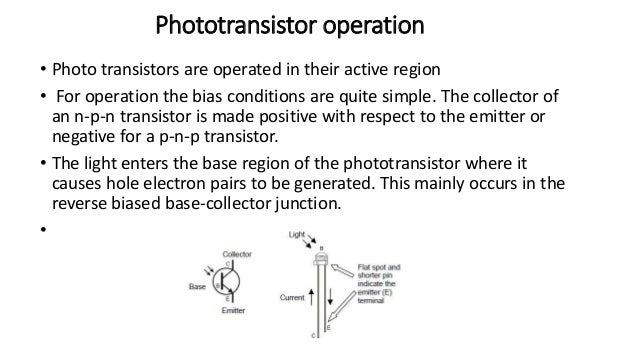

The typical common emitter and common collector photodiode circuits are shown below. One way to increase the optical saturation threshold in this application is to place a small piece of filter glass in front of the device. This provides a simple optical switch with a fixed threshold. In the 2-port NPN configuration, incident photons and the resulting excited charge carriers in the base can bias the transistor, which drives current through the output. The 3rd port is connected to the base/gate region, just like in a regular transistor. Unlike a regular transistor, a phototransistor can be used as either a 2-terminal or 3-terminal device. Contrast this with a photodiode, where no external bias is required to extract a current. This switching behavior makes phototransistors useful in a number of applications that require an ON and OFF state. When incident light is intense enough, the base-emitter voltage becomes small enough that a current easily flows through the device. In other words, a phototransistor acts like a switch with a built-in threshold. In contrast with a photodiode, a phototransistor requires some external bias (either common collector or common emitter) to extract current. This effectively increases the base current into the device. When incoming photons have greater energy than the optical bandgap, charge carriers are excited in the base/gate region. The base/gate in these transistors is triggered by incoming light, which excites charge carriers in this region. These are generally built as NPN or PNP bipolar transistors, or as FET transistors. Just as photodiodes have similar structure as a regular diode, a phototransistor has similar structure as any other transistor. The difference between them arises in that an increase in the output current from phototransistors and photodiodes is triggered by incoming light, rather than by changing the input voltage. Phototransistors and photodiodes are analogs of regular transistors and diodes, although phototransistors and photodiode work like photovoltaic cells in that they convert light to electricity. Photodiodesīefore getting into phototransistors, it helps to understand how they are different from photodiodes. These circuits are simple enough that they can be brought into standard configurations in transistors, and their behavior can be easily adjusted by applying a base/gate voltage. This circuit provides linear response or stable switching behavior when photons are incident in the gate/drain region, creating an easy-to-use optical switch for a variety of applications. However, one very useful option is a phototransistor circuit. When we think of optical sensors, we usually think of something like a CCD, CMOS sensor, or photodiode. Your next electro-optical system might need a photodiode circuit.


 0 kommentar(er)
0 kommentar(er)
